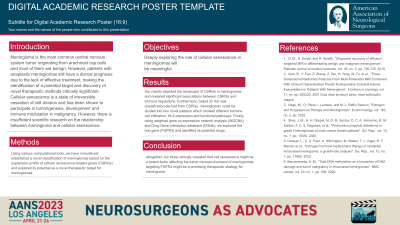Comprehensive analysis uncovers molecular subtype and immunological characteristics of meningiomas based on cellular senescence patterns
Comprehensive Analysis Uncovers Molecular Subtype and Immunological Characteristics of Meningiomas Based on Cellular Senescence Patterns
Friday, April 21, 2023


Bingyan Tao, MM (he/him/his)
Postgraduate
Chinese PLA General Hospital
Beijing, 11, China (People's Republic)
ePoster Presenter(s)
Introduction: Meningioma is the most common central nervous system tumor originating from arachnoid cap cells and most of them are benign. However, patients with anaplastic meningiomas still have a dismal prognosis due to the lack of effective treatment, making the identification of a potential target and discovery of novel therapeutic methods critically significant. Cellular senescence is a state of irreversible cessation of cell division and has been shown to participate in tumorigenesis, development and immune modulation in malignancy. However, there is insufficient scientific research on the relationship between meningioma and cellular senescence. Therefore, deeply exploring the role of cellular senescence in meningiomas will be meaningful.
Methods: Using various computational tools, we have innovatively established a novel classification of meningiomas based on the expression profile of cellular senescence-related genes (CSRGs) and explored its potential as a novel therapeutic target for meningiomas.
Results: Our results depicted the landscape of CSRGs in meningiomas and revealed significant associations between CSRGs and immune regulations. Furthermore, based on the new classification derived from CSRGs, meningiomas could be divided into two novel patterns which showed different immune cell infiltration, HLA expression and functional pathways. Finally, using weighted gene co-expression network analysis (WGCNA) and Drug-Gene Interaction database (DGIdb), we explored the hub gene (FGFR3) and identified its potential drugs.
Conclusion : Altogether, our study strongly revealed that cell senescence might be a potent factor affecting the tumor microenvironment of meningiomas, targeting FGFR3 might be a promising therapeutic strategy for meningioma patients.
Methods: Using various computational tools, we have innovatively established a novel classification of meningiomas based on the expression profile of cellular senescence-related genes (CSRGs) and explored its potential as a novel therapeutic target for meningiomas.
Results: Our results depicted the landscape of CSRGs in meningiomas and revealed significant associations between CSRGs and immune regulations. Furthermore, based on the new classification derived from CSRGs, meningiomas could be divided into two novel patterns which showed different immune cell infiltration, HLA expression and functional pathways. Finally, using weighted gene co-expression network analysis (WGCNA) and Drug-Gene Interaction database (DGIdb), we explored the hub gene (FGFR3) and identified its potential drugs.
Conclusion : Altogether, our study strongly revealed that cell senescence might be a potent factor affecting the tumor microenvironment of meningiomas, targeting FGFR3 might be a promising therapeutic strategy for meningioma patients.
